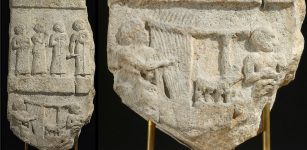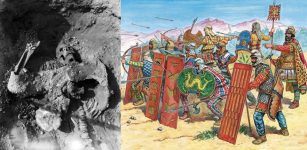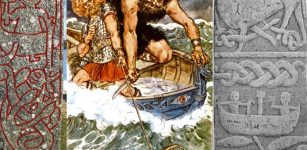Mysterious Hammer Of Thor In Canada Was Built Before The Arrival Of The Inuit – Did Vikings Raise The Monument?
Ellen Lloyd - AncientPages.com - On the desolate north bank of the Payne Estuary, 15 miles above the village of Payne Bay, near the west coast of Ungava Bay, northern Quebec, Canada, there is a very curious ancient monument resembling Thor’s Hammer.
The monument is a two-ton stone structure, about 8 feet high, and measures 4-1/2 feet across at its pointed lintel, surmounted by a 14-inch-high capstone. It is unknown who raised the monument, and there is some dispute about its builders.
Left: Hammer of Thor, Canada - Credit: Lkovac - CC BY-SA 3.0 Wikipedia - Right: God Thor with his hammer - Mårten Eskil Winge Public Domain
The structure was discovered in 1964 by archaeologist Thomas E. Lee during an anthropological expedition to Ungava. Lee was struck by its roughly Nordic design and dubbed it “the Hammer of Thor.”
God Thor is considered a hero of the Vikings, and his hammer has long been the Vikings’ amulet of protection and power. Thor is often depicted with Mjölnir, a magical hammer in his hand.
According to Norse specialist Ellen Davidson, “it would seem indeed as though the power of the thunder-god, symbolized by his Hammer, extended over all that had to do with the well-being of the community. It covered birth, marriage and death; burial and cremation ceremonies; weapons and feasting; traveling; land-taking, and the making of oaths between men.
The famous weapon of Thor was not only the symbol of the destructive power of the storm and of fire from heaven but also a protection against the forces of evil and violence.”
What is a monument resembling Thor’s Hammer doing in Canada? Archaeologist Lee learned from the native Inuit that they have known about the structure’s existence for generations, but their ancestors did not build it. The Inuit never worked in stone on such a large scale, and the monument was there before the first of their ancestors arrived in the area.
A silhouette showing the approximate size and shape of the monument. Credit: Wikipedia
The purpose of the Hammer of Thor remains a mystery, and some think Vikings raised the stone structure.
It is by no means impossible the Hammer of Thor is an ancient legacy of the Vikings. Similar stone structures appeared throughout Viking Age Scandinavia; the Temple of Thor in Sweden dates before 1125.
There is archaeological evidence that Nordic seafarers voyaged at least as far as Newfoundland and that they certainly did not lack ships to bring them to Quebec from relatively nearby Greenland.
The Vikings were the lords of the oceans. One of the main reasons behind the Vikings’ success in reaching distant lands lies in their remarkable longships. The Vikings’ ships were the European Dark Ages' most significant technical and artistic achievement. Without these great ships, the Viking Age would never have happened.
Thor’s Hammer was the period's most commonly reproduced religious object, which could explain why we find such a stone structure in Quebec.
Updated on August 26, 2024
Written by Ellen Lloyd – AncientPages.com
Copyright © AncientPages.com All rights reserved. This material may not be published, broadcast, rewritten or redistributed in whole or part without the express written permission of AncientPages.com
More From Ancient Pages
-
 Vandalism – Stonehenge Sprayed With Orange Paint – Two People Arrested
Places | Jun 19, 2024
Vandalism – Stonehenge Sprayed With Orange Paint – Two People Arrested
Places | Jun 19, 2024 -
 Mesopotamian Music Stele That Commemorates Gudea King Of Lagash In Temple Foundation Ceremony
Artifacts | Dec 12, 2016
Mesopotamian Music Stele That Commemorates Gudea King Of Lagash In Temple Foundation Ceremony
Artifacts | Dec 12, 2016 -
 Danger Lurking In The Woods – Mysterious Vanishings, Deaths And Unusual Behavior – Part 3
Featured Stories | Jul 9, 2018
Danger Lurking In The Woods – Mysterious Vanishings, Deaths And Unusual Behavior – Part 3
Featured Stories | Jul 9, 2018 -
 On This Day In History: Ruler Of Palenque Yohl Ik’nal Was Crowned – On Dec 23, 583
News | Dec 23, 2016
On This Day In History: Ruler Of Palenque Yohl Ik’nal Was Crowned – On Dec 23, 583
News | Dec 23, 2016 -
 Ancient Persians Were Familiar With Chemical Warfare 2,000 Years Ago
Ancient History Facts | Jun 4, 2018
Ancient Persians Were Familiar With Chemical Warfare 2,000 Years Ago
Ancient History Facts | Jun 4, 2018 -
 Danger Lurking In The Woods – Strange And Unexplained Sightings – Part 2
Featured Stories | Jul 7, 2018
Danger Lurking In The Woods – Strange And Unexplained Sightings – Part 2
Featured Stories | Jul 7, 2018 -
 Mystery Of The Bloody Island Poveglia – A Place Of Hell In Ancient And Modern Times
Featured Stories | Jan 21, 2016
Mystery Of The Bloody Island Poveglia – A Place Of Hell In Ancient And Modern Times
Featured Stories | Jan 21, 2016 -
 On This Day In History: Zhao Kuangyin Became Emperor Taizu Of Powerful Song Dynasty – On Feb 4, 960
News | Feb 4, 2017
On This Day In History: Zhao Kuangyin Became Emperor Taizu Of Powerful Song Dynasty – On Feb 4, 960
News | Feb 4, 2017 -
 Thor’s Hammer Pendant Found In Norfolk May Be Linked To The Great Heathen Army
Archaeology | Oct 24, 2023
Thor’s Hammer Pendant Found In Norfolk May Be Linked To The Great Heathen Army
Archaeology | Oct 24, 2023 -
 Unusual Iron Age Cemetery Discovered In Dorset, UK
Archaeology | Jul 11, 2022
Unusual Iron Age Cemetery Discovered In Dorset, UK
Archaeology | Jul 11, 2022 -
 From A Modest Town Jerusalem Has Evolved Into A Grand Metropolis
Archaeology | Sep 24, 2024
From A Modest Town Jerusalem Has Evolved Into A Grand Metropolis
Archaeology | Sep 24, 2024 -
 Ancient Burial Site Flagstones In Dorset Is Older Than Stonehenge
Archaeology | Mar 7, 2025
Ancient Burial Site Flagstones In Dorset Is Older Than Stonehenge
Archaeology | Mar 7, 2025 -
 Rare 4,500-Year-Old Stone Sculpture Of Canaanite Goddess Anat Found By Farmer In Gaza Strip
Archaeology | Apr 26, 2022
Rare 4,500-Year-Old Stone Sculpture Of Canaanite Goddess Anat Found By Farmer In Gaza Strip
Archaeology | Apr 26, 2022 -
 Hatra: Ancient Powerful Caravan City That Could Withstand Invading Roman Armies
Featured Stories | Dec 12, 2020
Hatra: Ancient Powerful Caravan City That Could Withstand Invading Roman Armies
Featured Stories | Dec 12, 2020 -
 History Of Bread: Basic Food Of Man In Ancient And Contemporary Cultures Around The World
Ancient Traditions And Customs | Jun 18, 2023
History Of Bread: Basic Food Of Man In Ancient And Contemporary Cultures Around The World
Ancient Traditions And Customs | Jun 18, 2023 -
 Oldest Footprints Of Pre-Humans Discovered In Crete – They Are 6 Million-Year-Old!
Archaeology | Oct 12, 2021
Oldest Footprints Of Pre-Humans Discovered In Crete – They Are 6 Million-Year-Old!
Archaeology | Oct 12, 2021 -
 Mosaics Discovered In Ancient Galilean Jewish Village
Archaeology | Jul 10, 2018
Mosaics Discovered In Ancient Galilean Jewish Village
Archaeology | Jul 10, 2018 -
 Groundbreaking Discovery Reveals High Cognitive Abilities In Humans Who Lived 170,000 Years Ago
Archaeology | Feb 7, 2022
Groundbreaking Discovery Reveals High Cognitive Abilities In Humans Who Lived 170,000 Years Ago
Archaeology | Feb 7, 2022 -
 Priam’s Treasure – Authentic Trove From Homeric Troy Or Deception?
Artifacts | Jun 11, 2021
Priam’s Treasure – Authentic Trove From Homeric Troy Or Deception?
Artifacts | Jun 11, 2021 -
 Thor And Tyr Journey To Hymir’s Hall To Steal Huge Cauldron – In Norse Mythology
Featured Stories | Jun 6, 2023
Thor And Tyr Journey To Hymir’s Hall To Steal Huge Cauldron – In Norse Mythology
Featured Stories | Jun 6, 2023


